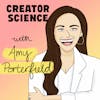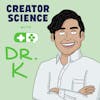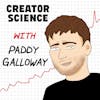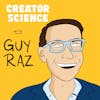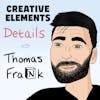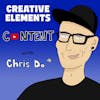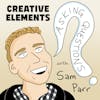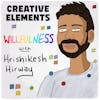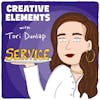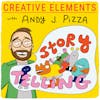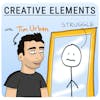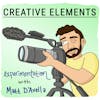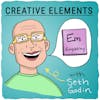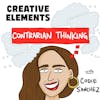
#93: Codie Sanchez – Growing a newsletter by dominating social media (in just over 2 years)!
Play EpisodeCodie Sanchez is the Founder of Contrarian Thinking and Cofounder of Unconventional Acquisitions. She helps people think critically and cashflow unconventionally while allocating to what she calls "sweaty & boring" small businesses.
Codie Sanchez is a reformed journalist, turned institutional investor to cannabis investor and advisor, to now Founder of Contrarian Thinking and Cofounder of Unconventional Acquisitions. She helps people think critically, and cashflow unconventionally while allocating to what she calls "sweaty & boring" small businesses. Most notably these are businesses in the micro-private equity space in traditional service-based industries.
Throughout her career, she has worked at the intersection of marketing and money, finding contrarian ways to invest.
Today, Codie has more than 150,000 email subscribers, 815,000 followers on TikTok, 209,000 followers on Instagram, and 123,000 followers on Twitter.
In this episode, we talk about Codie’s bet on being a content creator, how she forms opinions, her exact content process and strategy for TikTok, Twitter, and Instagram, why she doesn’t recommend Substack, and why Contrarian Thinking is a skill we all need to hone.
Subscribe to Contrarian Thinking
Follow Codie Sanchez on Instagram
Follow Codie Sanchez on Twitter
Follow Codie Sanchez on TikTok
Follow Creative Elements on Instagram
Full transcript and show notes
***
SPONSORS
***
IF YOU LOVE CREATIVE ELEMENTS
Subscribe to weekly episode emails
Leave a review on Apple Podcasts
***
ABOUT JAY CLOUSE
Subscribe to my newsletter, Creative Companion
***
FOR PODCASTERS
Enroll in my podcasting workshop
Enroll in my course on podcasting, Podcast Like The Pros
***
PODGLOMERATE NETWORK
This show is a part of the Podglomerate network, a company that produces, distributes, and monetizes podcasts. We encourage you to visit the website and sign up for our newsletter for more information about our shows, launches, and events. For more information on how The Podglomerate treats data, please see our Privacy Policy.
Since you're listening to Creative Elements, we'd like to suggest you also try other Podglomerate shows surrounding entrepreneurship, business, and careers like Rocketship.fm and Freelance to Founder.
Learn more about your ad choices. Visit megaphone.fm/adchoices
Codie Sanchez 00:00
This is like the secret if anybody's listening that actually wants to do it is like social growth has been 10x, anything else we do for the newsletter. I mean, 10x, we basically go from rented platforms, aka TikTok, Twitter, Instagram, whatever. And we take them to our own platform, which is our newsletter.
Jay Clouse 00:19
Welcome to Creative Elements, a show where we talk to your favorite creators and learn what it takes to make a living from your art and creativity. I'm your host, Jay Clouse. Let's start the show. Hello, my friend, welcome back to another episode of Creative Elements. This is a really great episode this week that digs into the weeds of social media content, strategy and process, and I can't wait for you to hear it. But first, I wanted to share an insight that I had in editing this episode. Last week, I mentioned that I've been working hard to create a home studio that makes recording incredible looking video easy. Well, I'm proud to say that it's all set up. It looks great. It sounds great. I'm super proud of it. I even have some smart outlets that let me turn on things with voice commands. But in editing today's interview, I actually realized that my decision to do the work on my home studio came from this conversation that you're about to hear. To peel back the curtain a little bit on this show, I typically record interviews one to two months ahead of when I air them. So by the time I'm editing an episode, I'm actually re listening with pretty fresh ears. They usually forget a lot of the specific talking points we had in any given conversation until I'm listening to it in the edit. But I'm noticing that even though I don't specifically remember some of the talking points, they have a noticeable impact on my decisions and behaviors so they must be in there subconsciously. There's a point in this conversation with Codie, today's guest, where she talks about how she built her home studio to lower the friction involved with the creative process. That comment made me think about my own studio. And without getting into the weeds, I had a lot of friction around creating video because of a specific quirk with my camera, a Canon M50 Mark One. So when I was investing in new equipment a couple weeks ago, I decided to invest in a new camera because I knew that it would lower the friction of creating. I didn't realize in that moment that my decision had been impacted by this conversation with Codie Sanchez weeks ago, but it definitely had been. And my point is this, the conversations we have with friends, peers, mentors, they often have a much bigger impact than we realize, even if they aren't recorded or we don't remember them, and it's a great reminder that we would be better off if we were more proactive and having those conversations. Okay, I'll step off my soapbox here and tell you about today's guest, Codie Sanchez. Codie Sanchez is what she calls a reformed journalist who became an institutional investor, and then a cannabis investor. She joined Vanguards ETFs business in 2008, she moved to Goldman Sachs, became an SVP at another institutional investing firm tasked with a $3 billion region. And then finally came to first trust a $63 billion firm to build the Latin America investment business from the ground up. Don't worry if those names and firms are unfamiliar to you. The point is, she had a very successful career as an investor long before she was building content here. She has an MBA, a PhD, oh, and as a journalist, she received the JFK award for print journalism. But if you have heard the name Codie Sanchez before, it's probably because she has become a prolific content creator. And her creative platform has really grown over just the last couple of years.
Codie Sanchez 03:45
I think I got talked out of being a writer and a journalist, because like that wasn't a reasonable thing to do if you wanted to be happy and married and like have money or whatever. And then this whole explosion of the internet happened. And then I was an investor and it was like the golden handcuffs that couldn't get away from it. And then I just started creating without the thought of making money. And now it's my favorite thing to do.
Jay Clouse 04:08
She's now the founder of her media company and newsletter, Contrarian Thinking, and co-founder of Unconventional Acquisitions. In her content, Codie helps people think critically and create cash flow unconventionally, through what she calls sweaty and boring small businesses.
Codie Sanchez 04:24
Well, it started really for two reasons. One is our name might give some of it away, I felt like people were losing this ability to question things. As a former journalist, and as an investor, which are the two things I sort of consider myself the most important things you can do and either one of those are hard to question. And if you start taking things at face value, you will quickly lose money.
Jay Clouse 04:45
Codie has a soft spot for these sweaty and boring businesses because she actually owns more than two dozen of them herself. 26 of her LinkedIn headline is up to date. These businesses include car washes, laundromats, pool service companies, and waste management companies. As boring as they are, they seem to be making for some pretty popular content for Codie.
Codie Sanchez 05:05
This guy turned literal trash into billion. Swain has Zynga turn waste management company which is now a $57 billion market cap into that by buying first one old, beat up, gross, trash truck. Then he made some money on that, scaled up, bought trash companies and created an absolute empire. The theory goes from smelly trash boring, he goes on to own sexy businesses like the Miami Dolphins, the Florida Panthers and the Marlins. So what do you learn from this? You don't have to have a ton of money to do M&A, you just scale up and two, maybe start with the unsexy things to become a billionaire. Follow on, we'll teach you more.
Jay Clouse 05:47
Codie's audience numbers are pretty staggering, and even more impressive when you take into account that she began the business in December 2019, just over two years ago.
Codie Sanchez 05:57
Yeah, we're, I think we're over 150,000 subscribers and probably something like a million total followers across our social platforms.
Jay Clouse 06:07
And those numbers are already a little dated because as of this recording, Codie has 815,000 followers on Tiktok, 209,000 followers on Instagram, and 123,000 followers on Twitter. So in this episode, we talk about Codie's bet on being a content creator, how she forms opinions, her exact content process and strategy for TikTok, Twitter and Instagram, why she doesn't recommend Substack and why Contrarian Thinking is a skill we all need to hone. I'd love to hear your thoughts on this episode. As you listen, you can find me on Twitter @jayclouse or on Instagram @creativeelements.fm, tag me, say hello, let me know that you're listening. And now let's talk to Codie.
Codie Sanchez 06:56
You know, there's this interesting thing in investing, which is Nicolas Nassim Taleb talks about as well, skin in the game. And basically what it means is that most people hold opinions for societal reasons for you know, moving forward within a corporate sphere, for moving forward, let's say in a societal sphere, like other people think like this, if I don't think like this, I could have negative repercussions. And because most people pulled opinions for those reasons, they don't have skin in the game, if those opinions end up being wrong, or sideways. Now, if you're an investor, if I hold an opinion, and my opinion is wrong, I will have a negative feedback cycle of losing money. And so my opinion that is wrong, I cannot hold for very long, and be very good at what I do for a living. And the same thing is true, typically, you know, in my realm of thinking for what a journalist is supposed to be, which is, you know, if you ask the wrong questions, and you have an opinion, and it's wrong, you're supposed to be fact checked, and, you know, or fired, really, that would be fraudulent. And so that's when we started Contrarian Thinking, I was like, we're losing this ability to question, nobody's doing it. And it might be the single most important thing to our progression as humans, and also if we want to make money, and I think financial freedom leads to all freedom. So that's why I started it so we can all think together and get rich together.
Jay Clouse 08:14
Interesting. Well, most people wouldn't say that starting a newsletter is the fastest way to making a living or making money. And obviously, you know, as an investor, you probably had a ton of options for how you could be spending your time to turn money into more money. So are you saying that the newsletter itself came from a place of almost being mission oriented, that you wanted to really help people think differently?
Codie Sanchez 08:38
Yeah, I mean, I'm not saying I'm Mother Teresa over here, you know, but like, yeah, I mean, I started it, because I wanted to do and I think everybody has that you have like that thing inside of you that you can't shut up for the want of everybody in your family wishing that you'd stop talking about it. And, you know, I think we push that down, and we cram it in there. And then you know, we focus on material things, because that's cool for everybody else, or we focus on the job, because that does the bank account building and, and I just have this thing inside of me, which like, wouldn't shut up, and I wouldn't shut up about it. And typically, that tells me that I have to do something with it. Otherwise, it just keeps cycling back. And so yeah, so you know, it was mission driven. Yes, because I think it's important, but also because I loved this topic. And I knew, you know, you know all about media. If you are going to be consistent in anything, it's going to be because you are interested in it. It's very hard to feign interest and then have consistency with something you're not into.
Jay Clouse 09:31
Yeah, totally. Were you not writing as much in your investment life as you were as a journalist, did you miss that?
Codie Sanchez 09:39
Yeah, you know, what actually pissed me off is, is this a therapy session or is this a podcast? But I remember I was at an investment firm at the time and I was a partner. So you know, I can kind of do what I want to do in a lot of different ways because I was one of the main people there. But I had to write these investor updates and these quarterly investment reviews for like, why did I invest in this? You know, why did I make this decision? Whatever. And I'm cool with that, I think you should have transparency and accountability. But what I didn't like is they started telling me how to write in my style. And they were like they sent me a, I can't remember who it must have been like something annoying, like, Berkshire Hathaway is, you know, saying they're like, this is how we want you to write it, or like Ray Dalio actually brochures is pretty good. It was like a dowel, it was very cut and dry and boring. And I was like, no, no, I'm just, I'm not gonna do that. And like, you know, insert F word. If you want to do it, go, go write it yourself. Oh, you can't because you're not very good writer. That's right. So that's why you come to me is because I'm a good writer. So I had that like little rebellious 12 year old inside me, that was like telling the man to go pound sand. And so at that moment, I was like, okay, I have to fight with them every single time about this same thing or I'm just gonna, I need my outlet somewhere else. And it's not going to be this. And I've already created these constraints for me here. So I'm gonna do this thing over here. So it started while I was working like 60 hours and private equity, just because like you said, I wanted to do the thing, and nobody would let me do the thing.
Jay Clouse 11:04
Are you one of these people who thinks by writing or do you think about your opinions, form the opinion and then write the opinion?
Codie Sanchez 11:14
It's a good question. I think it's actually a mix. I don't know about you but every time I start writing, I usually start reading. So I'll start like, in less than, like, run around and I'm like, brilliant idea, everybody shut up, gotta write it down right now. I will usually be like, I want to get into the flow, because I think I can't remember who it says. But it's like creativity is basically bogus, and like, inspirations bogus. And you just have to create inspiration for yourself. And so I make myself write every single day. And now it's a joy that I get to write, it used to be I make myself write, when I'm in that, hey, it's my writing time, I'll pick up a great book, you know, that I love. And I'll start by reading somebody words that I think are better than mine. And then that will spur a bunch of thoughts. And then I'll have topics sort of figured out, and I'll take they're like beautifully written words in the topics that I kind of want to go and then rabbit holes ensue. But when I'm thinking about something intensely, yes, like my one of my partners, and one of my businesses, unconventional acquisitions, Ryan, he likes to talk through ideas, and I want to kill him. I'm like this, it does nothing for me. You got to find a girlfriend or something to talk about your ideas with because I if we're actually going to brainstorm, I need to quiet and like a pen and a candle.
Jay Clouse 12:19
I love that. You've mentioned the word opinions here a couple times, and asking questions, I would love to understand in your day to day life, how you actively keep that front of mind? And the reason I'm asking that is, I find myself just often opting out of having opinions at all. Like most of them, I just don't have an opinion on anything until someone says, what's your opinion on this? And then I start processing like, okay, if you're gonna ask me for my opinion, I guess I'd better start thinking about it. So I'm curious if you have a different way of approaching the world, to force yourself to take a stance on things.
Codie Sanchez 12:53
I, there's a some saying that I've always liked, which is that you should always have a competition of ideas going on in your head. And that goes back to that old adage of, you know, strong opinions loosely held, right? And so I have a lot of opinions, but I don't die on the sword for them. I'm very, I mean, just today, it was a contentious issue that we saw on a news outlet. What was it? Joe Rogan's new interview with Robert Malone, who's like a kind of contentious virologist, he got kicked off of Twitter. And so I sent it to a friend on the left, and I sent it to a friend on the right. And I said, what do you think about this? And then, you know, both of them came back to me with something or other. And I said, well, give me a source that says credible and this section is this one and same thing in this one, and then I said to both of them, I'm not interested in being riot, I'm much more interested in learning the truth. And so, the way that opinions formed to me are just this, it's a journalistic urge to find the truth. And then once I think I found the truth, in that instance, whatever it is, then I like to share it and it's basically a way to stress test my truth. And it probably stems from the fact that I think one of the most powerful things that I can glean always is information, and information, categorized and organized towards the action is really just an opinion, right? So if you just have information, but you don't take any action on it, then it's not an opinion. It's just a fact, right, or it's a statistic or it's a whatever. And so that's sort of how I think about the world. But yes, I don't think there's a dearth of opinions. I don't think people are running around like, I think nothing and like let me throw a few angry buzzwords in the mix. You know, for no reason, I think lots of people have opinions. I wish we just let them fight. I wish we treated our minds like boxing rings, you know, and we're like, I want to build an exceptional boxing ring. And then whichever boxers are in there fighting, awesome, go at it, but my ring is going to be meticulous.
Jay Clouse 14:42
Yeah, I agree with that. I believe people have very strong opinions, but it doesn't seem to me that we are forming them independently as often, which is like, great news and opportunity for creators and influencers and people running media companies, but also like you said like pretty scary that people you know, they have their trusted source of this and their opinion is now my opinion. I put it on like a jacket.
Codie Sanchez 15:07
Yeah, yeah.
Jay Clouse 15:09
I've heard you. In the research I was doing as listening some other interviews that you've done. And you just mentioned, you know, you texted your friend on the left and a friend on the right. It always seems like you have friends that you spar these ideas with? Do you do that because you want to create content around it or did you naturally have that behavior before you're even creating content?
Codie Sanchez 15:29
Yeah, I think that's been a natural. You know, when I was younger, my parents had four chairs in our living room. And a lot of people circle around the dining table, perhaps that's where like your family hung out, or maybe in front of the TV, watching football, everybody usually has a familial nucleolus. That's physical. And ours were these four armchairs my brother, myself, my mom and my dad, and what we would do for hours, which we kind of joke about now is we were just talking about things. I like this. I know that's a ridiculous idea. I like this one. What do you think about that one? So that sort of came naturally to me. And I am hugely uninterested in talking about people like, oh, did you see she did this and this, don't care. You know, like, oh, the weather, so uninterested. And so what instead intrigues me is this search for knowledge and truth. I had no idea other people would be interested in it. Like, honestly, people, like what's your content strategy? And I'm like, well, I've tried to do the avatar thing, right? Like, this is who I serve. And then I've tried to do the, you know, here are like demographics and whatever. And then what I always end up doing is just creating the stuff that I think is interesting. Usually, the stuff that I think is interesting, people will think is interesting. And the second, I try to copy somebody else or I try to do something because it's trending or whatever. And so it's embarrassing, it totally flops. So yes, I think I've always had that. But I think everybody has that. And the problem with most of us why we can't create content like that, is because what do we do? We mouth off every time telling everybody else our opinions, instead of shutting up and listening to your landscaper. This is ridiculous. People won't be able to see this on the podcast, like look at this ridiculous thing. So this is like
Jay Clouse 17:01
This is like a Freddy Krueger situation.
Codie Sanchez 17:04
It's like a, like a, like a Wolverine. It's a legitimate Wolverine, like three pronged metal thing that you like hold in between your three fingers, like you would not want to come into my office right now we have our questions. And the reason I have this ridiculous thing is that I befriended our landscaper, who's been working for us, we're redoing our backyard. And it has been just Maverick. And he only has one tooth in the front and kind of wiggles when he talks. And he's all tattooed up. And we've gotten to know each other, and he uses this in the yard. And so he's this really kind of scary looking guy with a huge knife. And he gave it to me. And the reason why is because I shot he doesn't know anything about me. But I sit down and like hear his stories. So I think a lot of people think about how to create content from your ideas. And my best content is often not my own ideas.
Jay Clouse 17:50
Yeah, totally or sometimes it's, for me, I find that it's my ideas that I don't express until somebody asks, so sometimes I like doing interviews simply because then I can write down the answers to questions someone else asked because, because I forget that's interesting to other people.
Codie Sanchez 18:06
Totally, totally agree.
Jay Clouse 18:08
After a quick break, Codie and I dive deep into both her process and strategy for dominating social media. And later we talk about her paid community and how she would change her approach if she started over. So stick around and we'll be right back. Welcome back to my conversation with Codie Sanchez. If you followed Codie's content on social media, you know that she loves to talk about buying boring businesses, things like car washes, RV parks, and laundromats. She can create content about those businesses because she owns them herself. In fact, she owns more than two dozen. So I asked her how she divides her time between content creation and her time investing in businesses.
Codie Sanchez 18:45
Yeah, today for the first time ever, and I've been investing for, I don't know, 13, 14 years, something like that. I'm doing more content creation. And that really switched probably the latter half of last year. So it's been maybe six months that it's been like this. But previously, you know, I was almost always doing deals, investing, buying businesses, selling businesses, looking at balance sheets, whatever. And I'm pretty decent at it. But I really like the content business. So 2022 of my focus is sort of doing more of the stuff that I'm interested in. And content, I think is the most interesting thing that almost any of us could be doing right now.
Jay Clouse 19:23
Why is that?
Codie Sanchez 19:24
Well, it's it goes back to Navall, I think was the first one who talked about this, but the four forms of leverage. So basically, he gives three forms. I add the fourth so he says, which I find to be historically correct. There are four types of leverage. The first type of leverage that was created was labor that's used to be slaves, then it was serfs and it was employees, right? So if I was a pharaoh, I had a lot of leverage because I have a bunch of servants and they have to build pyramids for me, right? Then the second type of leverage that came out was capital. And so capital came out during the banking reform in the US which is right when the Rockefellers and the Rothschilds and those big names became titans of industry. Why? To create a huge energy company, you need money, you need other people's money, aka capitalist leverage. The third type of leverage was code. And that was created by, you know, on the breath of the internet, right? So we have the Bezos and the Musk's, and the Gates all created their empires based off a little army of code working for them online. And the most recent type of leverage I think is audience and audience is essentially a different type of employee. It's like people working for you for free, platforms working for you for free. And so as a financial sort of person, or investor, by trade, I'm always interested in the lever points, how do I do less work but have more input, right? How do I take less risk, but get a higher return? And so that it right now is, is content in my opinion, and anytime you have a new form of leverage, that, you know, to the first go the spoils. And so I think now is the time to double down on it.
Jay Clouse 20:59
I love those. Thank you for sharing those four pillars, totally agree with adding audience in there. Part of me thinks well, that probably existed when Hearst was doing newspapers, you know, like audiences and completely new. Do you think we're in a notably different time with audience as a leverage point?
Codie Sanchez 21:18
Yeah, I think so audience existed before, but I still think it wasn't the main pillar. It wasn't, so even when Hearst and and you could say like, you go all the way back to the, you know, the Gutenberg Press, right? I think the the difference today is that that was still such a political game, right? So you had to actually have distribution rights that were allocated inside of cities, it was a capital intensive game. And today, you don't have to have any of that. It's like democratize in the same way that you had code pre the internet, right? You had like hard wiring of code that you could do in varying types of super large computers. But it wasn't so democratized. And today, I'm not sure it's ever been so democratized, maybe it'll just continue to. But that would be the difference.
Jay Clouse 22:07
Means of creation got a lot cheaper.
Codie Sanchez 22:09
Means of creation, absolutely, and the means of distribution. You know, it would be very hard previously, I mean, could you imagine a newspaper going, quote unquote, viral and having millions of views within a weekend, like that would be really tough, they'd have to distribute the actual newspaper to millions of people?
Jay Clouse 22:26
Well, part of the reason I got really excited to talk to you is because you started Contrarian Thinking beginning of 2020. And a marked an interview that you did with Nick Loper on the Side Hustle show, and that was about eight months in and you'd gone from zero to 55,000 subscribers and about $50,000 in revenue. Then you talk to Nathan Barry in March of 2021, 102,000 subscribers,
Codie Sanchez 22:48
But just wild when you say that I kind of forgot we did that. I guess we should take a pause sometimes.
Jay Clouse 22:54
It is wild, and you know, to reflect back some of the other things that maybe listeners don't know, 103,000 followers on Twitter, 64,000 Instagram, 527,000 followers, 520, 700,000 followers on TikTok. How much do those platforms feed the growth of the newsletter? And is that the central point that you're trying to move people towards?
Codie Sanchez 23:16
Yeah, I mean, this is like the secret if anybody's listening that actually wants to do it is like, social growth has been 10x. Anything else we do for the newsletter, I mean, 10x, we basically go from rented platforms, aka, TikTok, Twitter, Instagram, whatever. And we take them to our own platform, which is our newsletter. It's the only platform that we can own outright, right, where I can control the distribution. Nobody can say the algorithm change, the national licensee, theoretically, Google could, I guess, kind of mess with it. So that's been the entire growth strategy, at least for the past, like nine months or something, since we've focused on it, pre that it was, it was tough, you know, I was like, putting LinkedIn messages in the message group and trying to get Facebook groups to grow, etc. But right now, all social funnels to the newsletter, and the only way we monetize is through paid products and a community on the newsletter. And maybe someday we'll do ads and sponsorships. But man, I'm nervous about that, because of the incentive alignment. And I want my customers to be my customers. And I want to have a third party shadow figure as a main customer. So I'm messing with that a little bit right now.
Jay Clouse 24:27
If I'm listening to this, I'm simultaneously encouraged that in 2022, there's still opportunity for me to build an email newsletter, and terrified because how can I as a solo creator, also maintain TikTok, Instagram, Twitter? How would you encourage someone to think about that if they're getting started? Would you go on all three platforms? Would you prioritize one of them?
Codie Sanchez 24:48
So I have a two minds on this. Well, first of all, for the first year and a couple of months, I did it all by myself while working. So like one I would say, yeah, do I work a lot? 100% admittedly, and you know, do I think that I have maybe developed the skill and muscle perhaps more than most that I just hammer out content? Yes, I do think that's the truth. That said, like, we're not curing cancer here. This isn't rocket science. Like, I'm not that smart. So I think it's totally doable for anybody, maybe not the speed, but maybe. So I would say, I started with, I had some a little bit of a following on Instagram, like 10,000, or something I don't even know. And so I find Instagram to be the hardest to grow by Speights. Instagram's super hard and it's established platform, I can't really figure out how to grow quickly on there. TikTok's a wild card and a half. I think if I was a creator today, starting a newsletter, I would write the newsletter consistently. And I would do TikTok because the virality inherent in TikTok is wild. That said, I think it's hard to make people love you on TikTok. In 30 seconds, you almost come off as like a little bit, you know, it's like, hey, how did you make $10,000 In five minutes doing nothing, you know, and then it's like, oh, of course, that went viral. But like, you know, so I think for virality, TikTok's great. I think for making people love you, Twitter is is better. I think YouTube, that's the platform we're gonna do this year, I'm the most interested in so most like this. Podcast, too but I think podcasts are hard to grow so good for you. And then Twitter makes people respect you, I think because you show a lot of you can show a lot of numbers and detail. So I guess, think about it from your perspective. What do you, what are you better at? You know, can you do long form video easier and get people to love you that way, then do YouTube? You know, can you do like short, quick pithy little videos, try TikTok plus no, no production value, whatever, you could just put your phone in front of your face like this. And then if you like to write and share more numbers and details and do threads do Twitter, I think you can start with one. Don't stay with one, though, because there's too much possibility for algorithm changes or for you to do something that one of the platforms doesn't like them to take you off, especially as you get bigger.
Jay Clouse 26:58
On the point of controlling distribution. I know you started your newsletter on Substack. I think today it's on ConvertKit.
Codie Sanchez 27:06
Yes.
Jay Clouse 27:06
And I know, you had like an issue with Substack. We don't have to get in the nitty gritty of that if you don't want to. But I would love to hear how you would encourage people thinking today about which EMS to start with, who have heard about Substack to think through that decision.
Codie Sanchez 27:21
You know, I think Substack and Ghost are fine for people to start on. I just think that to charge 10% of your subscription revenue for a glorified Squarespace WordPress hosted website is a joke. And that's what Substack does. And then what they did to me, I was so surprised. They basically shut off our Substack without telling us, without warnings, without anything because we had products that weren't running through Substack. And I am an entrepreneur multiple times over I invest in ton of businesses, so I hate to give shit to founders. It's like a hard enough business. But the way they handled it was so atrocious. I think their head of marketing only got back to me on Twitter after I posted a thread that got 10s of 1000s of views and their investors started tagging them. And the first thing she DM me on Twitter was like this emoji you guys can't, you guys can't see it but I'll explain it to me like that, oh my gosh face with two hands across your head and then like the cover my mouth with one hand face and then like a bright red face. And was like I heard what happened to your Substack, I'm like, am I in Fantasyland? How is this how you're reaching out to me right now? She's like, I bet that was annoying. I'm like, annoying. I'll show you annoying. And so anyway, I don't like when people mess with creators because it's so hard to be a creator actually, even though it's like, oh, it's me. You know, people are working in the fields. But it is it's a hard thing. And thankfully, I have other income streams that didn't really matter to me. However, I now have people who work for me that rely entirely on the revenue from this business. I don't take any money from this business right now. I only pay my team and put the rest towards growth. But imagine that this was my actual business. And I had people that needed to make money from it and they just shut off your business. Okay, so that's my warning. Be careful about using those sites. Yet, when you first start out, they're great, because it's super easy. I go with Ghost over Substack because they don't have that likelihood or tendency. But then eventually, you need to build your own platform, in my opinion, even though it sucks and I hate building it. I wish that I could just use Substack.
Jay Clouse 29:23
Are you saying if I'm doing a newsletter and I'm going to commit to TikTok, I'm basically doing 30 to 60 seconds. Let me hit the highlights of what I wrote this newsletter about so your repurposing it in that way?
Codie Sanchez 29:34
I do try to repurpose everything. You'll notice my content across all platforms echoes, you know, it doesn't mimic. But yes, if you're creating one incredible newsletter minor pretty long, and you're not turning it into 5 to 10 pieces of content, then you probably are driving yourself crazy. So I like to go and learn platforms as they go. So I might start with like, okay, I'm going to get kind of obsessed with Twitter. And I might hire an intern to do the posting for me or get a schedule or like buffer or something like that. I use Hypefury for Twitter much better than any other platform. TikTok, we post natively because it actually helps a lot. Instagram, we schedule out with buffer, and the newsletter, we created our own website, but we use ConvertKit on the back end. And so I try to schedule out as much as possible. But yes, repurpose your content 100%. But for TikTok, you kind of got to throw the newsletter out of the equation in my mind, as far as like the summary or whatever, I think you just need to watch TikTok pretty intensely for like two weeks, it's not, you know, probably not great for your mental health, but just consume a bunch of it. Tag the videos that you like, and then start asking yourself this question, how could this viral video apply to what I do? How could this viral video apply to what I do? Save all of those and then go try to make those viral videos, something about your underwater basket weaving newsletter, right?
Jay Clouse 30:55
And are you doing the creation of all those video assets yourself? Because they look great, even have cut ins of illustrations and things, are you doing the editing yourself?
Codie Sanchez 31:04
No, no, no, no way, I would definitely not be able to keep up with that. But you know, our team's super lean. And I think you know, I'm probably the exception here. So with about a million person audience across it, which really ballooned over the last, let's call it three months. Not that many people do multiple platforms. So you do not have to do it. Like Anthony Pompliano, he really dominates YouTube and Twitter. That's it. That's all he does. And YouTube's newer for him. And Twitter, he's been a killer app forever. So you can totally pick your platform, TikTok, I have pretty edited videos on there. But a lot of people just hold up their phone and edit in the app. It's just not. I'm like, I'm 35. So I'm like slightly past the age where I'm pretty good at that.
Jay Clouse 31:49
So you're creating the asset, and then uploading it to TikTok.
Codie Sanchez 31:53
So basically what I do now, for TikTok that's, I almost treat TikTok like YouTube. So we have a workflow, all of our workflows go and notion, you know, I go from like idea to a developed script, to a ready to film script that I filmed them, then I take that script, and I give it to our editing team. It's a one guy team. And he basically wrote, like, all kind of write a little guideline for everything I do. It'll say like, here's what a Codie Tiktok video looks like. So take any of these videos and make them look like a Codie Tiktok video.
Jay Clouse 32:27
Got it.
Codie Sanchez 32:27
And then I batch the content creation once a week so I film once a week.
Jay Clouse 32:31
Got it, what's your film day look like?
Codie Sanchez 32:34
Well, it's because there's a lot to be desired now we're trying to figure this out. But I'm looking at my office right now there's like a camera. So you probably know this but when it comes to heavy content creation, and like turning your content into a business, so like, you do not have to start like this. But let's say you want to make that you know, million dollar content business, it's all about, in my mind, decreasing friction to creation, the more friction or more difficulty it is to create, the less you're going to do it, even if the friction is five minutes. So I have like a camera that's looking me in the face right now. I have like littered all around here, like you know, little tripod, things that all like stick in other different locations that are like easily accessible to grab. I have a ring light that I just like flip on it's 20 bucks from and all this stuff is like 20 ish bucks from Amazon. I have like a little, what is this? What is this called? Like a
Jay Clouse 33:22
Lavalier microphone.
Codie Sanchez 33:24
Yeah and it plugs into your phone. 20 bucks on Amazon too. And so all this stuff is kind of like shitting right here. And on film day, I will you know how you go to write a newsletter, I try to write same time every single week and when inspiration hits, but same time every week, it's a job. And I do the same thing with scripts. So I'll have one day a week where I read a bunch of different scripts for Tiktok and now YouTube, and I'll take those scripts and we'll hammer through them in a day. And I want to get more creative and do vlog style and stuff so that'll happen going forward. But for right now, it's you know, point and shoot and kind of execute.
Jay Clouse 33:59
You're saying we, when you say we hammer through them? Do you have somebody there helping you?
Codie Sanchez 34:04
Yes, when I film now I have a videographer, his name's Samuel. He's awesome. And you know, you don't have to start like a lot of my friends who are big creators, they don't have a set videographer. Again, I like to decrease time to friction. And video is not my most native tool. So I'm like kind of obsessed with the production of it. I think of myself as the executive producer. Like, almost like when you think about a movie, you know? You don't have Spielberg actually filming, oh my god did I just compare myself to Spielberg? Anyway you know, you don't have the the director sitting behind the camera all the time doing all the different things. They're kind of thinking like a high level they're storyboarding, whatever. And then you have the real specialist who's like, what if we then you know, make it look like you're jumping out of the ocean? And so that I think is the difference.
Jay Clouse 34:54
I love that thanks for going into the weeds with me here on some of this because even though this is you know, several steps ahead of where probably the average listener is at, I think it's good to know what you're aiming towards several steps down the road. And you know, we've covered a lot of that, like, how to get your first 100 people on here, which is super valuable, very, very, very necessary. But I like to go into the weeds, especially with someone who's done this. So recently, because I had Tim Urban on the show in Tim's awesome, you know, he had a similar approach where he says, I write for a stadium full of Tim's.
Tim Urban 35:25
I start to realize that goes like, okay, my like weird interests, like a lot of people have those same interests, you know, this isn't. And so this is like the beginning of me being like, okay, I find, if I find something fascinating, I'm going to assume there's 100 stadium of Tim's out there who are going to agree exactly. And I just started doing exactly what I wanted to write about, like, what I was interested in, regardless of viral stop, stop thinking about going viral. And now it was just trying to delight the current people that were there. And I was just trying to do that by following my own interests.
Jay Clouse 35:52
But he hit Facebook in 2014, when Facebook was trying to push content, like we can't do that today.
Codie Sanchez 35:59
Totally. I also don't trust people that are like, I just went viral on here. Like, I don't even know what happened. The video just got huge. And then my newsletter had millions of subscribers. And next thing you know, you know, I'm on Oprah. And so you know, when there are people that say stuff like that, I'm like, no way, like, you were in your basement hammering away at 2am in the morning, and like the rest of us. So I think it's like good to be honest about the fact that if you want to be a content creator, it's a blast. I love what I do. But like, it is a job. That's why I share all this stuff. Because most of the people listening are never going to do any of this even if I gave you the login to everything that I do. That's like a 1%, you know.
Jay Clouse 36:36
Yeah, I've thought about creating a series of courses on like, why not to create an online course, why not to do a newsletter, because I feel like if I can talk you out of doing it, you're welcome for saving you for the time of trying, like you need to tell me
Codie Sanchez 36:50
That was funny, that's a good idea. You should do that. You should totally do that.
Jay Clouse 36:56
When we come back, Codie and I talked about her Twitter strategy, how she would build a community if she started over today, and her feelings on subscription memberships. Right after this. Hey, welcome back. A little bit earlier, Codie told us that social growth has been 10x more effective for growing the Contrarian Thinking newsletter than anything else. I wanted to get a little bit into the weeds here, because it makes sense to build an audience on social media and then port them over to a platform that you actually own and can communicate with more reliably. But how does that porting happen? So I asked Codie, how much intention she puts into calls to action from her social media posts to subscribe to the newsletter?
Codie Sanchez 37:36
On Instagram, we're pretty good at doing that, we do that quite a bit like it's in my little link up top. In the captions, they're talking about it quite a bit, it looks like something like maybe one out of three times, one out of five times, something like that. We tell people to go subscribe, you know, on Twitter, we probably post about it once every other day or something like that. Go subscribe, try to do in the creative, cute way. And then on TikTok, pretty much every time we're like, if you want more information, there's a free newsletter, the link in the bio, and, you know, I try to think about it like a service, since most of the stuff we do is free, like 99.9% of the stuff we do is free. It's not like I'm, you know, trying to hump them over to $10,000 products. You know, it's, it's where the actual answers to their questions are. But maybe one other thing I just say is like, do not feel bad about charging people for things. The entire reason like the media is so screwed up right now is because we have bad incentives, because people thought they were getting free products. And as we learned when a product is free, you are the product. And so this one is hard for me, I still like people, people are nasty on the internet. And so they'll say things like, oh, this is a scammer, it's a course, another group, you know, and I'm like, you know, and I'm always asking myself, is that true? Is there any part of this that I'm posting to be contentious to get more people to buy our stuff? And we try, I try to be really careful about that. And I don't think that that's true, I think in fact, you should charge for things and just in the best interest of the people because guess what, they'll ask for a refund if it's not good. And that is what you should get, you should get a refund if something's not good, instead of have to refund all the ideas that have been put into your head by people that just had bad biases due to advertising. So charge for your product and whatever you think the prices that you're gonna charge for your product charge more.
Jay Clouse 39:28
So good. I want to get to the paid newsletter here shortly. But before I get off of the topic of social media, how do you think about threads as part of your Twitter strategy? Is that core to your strategy? I see that you have a lot of them, but you also have a lot of single tweets.
Codie Sanchez 39:43
Yeah. Well, single tweets are 100x easy, maybe not a 100, like 10x, 20x probably easier.
Jay Clouse 39:51
than 100x easier.
Codie Sanchez 39:53
Yes, exactly. And not only that, but like I have a team that will help me think of ideas for tweets. And we kind of like I think about it a little bit like, like, we try to be like, you know how they talk about Saturday Night Live, like they get together in a room. They like eat a bunch of doughnuts and drink bad coffee and like, throw stuff at each other and think about what's going on. That's what me and my team tried to do. And so I tried to do that with with tweets and stuff that we're doing, that's really easy to do with everything except threads. Threads to me, are like an art form. And I have tried to have other team members write them, and it never works out even when I give them the whole thing. I haven't perfected that yet. And yet, I think threads are 95% of the way to grow on Twitter, thread to done well.
Jay Clouse 40:39
That's why I asked that was my assumption. And I was like, I wonder, I wonder if you could validate that.
Codie Sanchez 40:43
Yep, yep. I'm even considering like getting rid of the one off tweets, because they just don't do as well. But then you become like that person who just posts threads all the time. It's kind of annoying to so I don't know.
Jay Clouse 40:56
You said in the last three months, things have really ballooned. I've had this assumption that there's some sort of audience escape velocity, to where it starts to really self perpetuate. Do you believe that? Have you seen that? Or do you have any evidence to the contrary?
Codie Sanchez 41:11
Yes, 100%. I mean, I'm sure that you can have pullbacks, if your content gets uninteresting, but at large, yes, for a long time, nobody cares, nobody cares, nobody cares, then even less than nobody cares, you decrease sometimes, then you get off a little bit and you decrease again and that's totally normal, at least in every business that I've built. But then you get to a certain level where if you're doing it right, people are interested consistently, they're bringing other people along. And it's almost like despite yourself, the only time I've seen that not always work is, you know, TikTok, for instance, because it plays to such virality, you'll have massive spikes. Whereas once you grow on something like Instagram or Twitter, you kind of just keep growing and you'll have like some other spikes, but you won't have a ton of like, way down, nobody cares. TikTok's not like that TikTok, you could have like, you know, 10,000 views, and then you could have 11 million views. And it doesn't they don't really care who you are. And so I do think that's true. That said though even once you start getting big and you grow massively, you'll still notice that on some channels, you're like, we're almost going over here, and we're not growing over here or maybe this is just me, this is what I do. And I'm always thinking about how can we tweak better for the channels for growth.
Jay Clouse 42:22
On the topic of you shouldn't be afraid to charge for your stuff. You have a paid version of the newsletter now, which isn't actually a paid version of the newsletter. It's actually a community and different types of content. I would love to talk about that decision, how you thought through it, and specifically pricing in in the value proposition that you're making.
Codie Sanchez 42:42
Yeah, so I don't know if I do it the same way again, honestly, it's too cheap. So right now, it's like, depends on when you post this, but it's like $399 for a year. And it includes a playbook a month on passive income stream. So like, my belief is you need to have multiple income streams in order to reach true financial freedom that stabilized and loaded. And so every single month, we come out with a new passive income stream, we write a playbook on it, which is a long form newsletter plus a bunch of templates and other stuff. And then we put it in a vault for you. And then we have a community on Facebook, where we talk about all this stuff, and then we have a weekly call, that is way too much for $399 a year.
Jay Clouse 43:18
That's a lot, yeah.
Codie Sanchez 43:19
Way too much. So what we actually should have is that product is going to go up in price, and they were going to charge $1,500 or something for it. So we're going to end up charging $1,500 for that product. And then we're going to have sort of like an intro, hey, if you want to get to know Codie, and Contrarian Thinking and what we do, here's a less expensive, you know, $99, $200 product or something that you can, you know, whet your whistle with, if you don't like us no harm, no foul, if it doesn't work, you move on, or you take a bigger bite of the pie. But I was so worried about underserving and asking for even $5 from the audience and then not liking it at first. But I was like, well, we'll get on this, we'll give them this, we'll give them this, we'll give them this. And that's a disservice so we should have, we should have made it simpler, probably.
Jay Clouse 44:04
Yeah, I had a similar thought recently, I've been eat, sleeping and breathing community memberships last year working with Pat Flynn and the Smart Passive Income team. And I'm coming to realize that in the world community, you should really be looking for like a minimum viable promise, like what is the minimum I can promise you that you are excited to buy into not so I can not deliver anything else on top of that. But because then it's not an expectation. You don't have to like exhaust yourself fulfilling 10 bullet points that you promised.
Codie Sanchez 44:33
Exactly. Yep. I think you're exactly right.
Jay Clouse 44:36
The challenging thing for somebody listening to this who might not have a level of scale that you do, who wants to build a similar modeled product, where community is a component, communities about the people and pricing on that it's really hard because you have to get a critical mass of people in there at the same time to start or the thing dies on the vine. How did you think about community as a part of your membership here? Why was that important to what you're building?
Codie Sanchez 45:00
Yeah, okay, I would actually not build a community until you have more scale, I wouldn't do it super, super early because exactly, if the term community itself basically means that you have other people that are able to sustain your community without you, otherwise, it's just a dictatorship, you know. And so I actually wouldn't go community upfront, again, I would go product, I would go like a course, or like a little sprint or a challenge, or whatever it is, I would sell something so that you can pay yourself for the time to keep creating, I think that's really important, because it's easy to burn out, especially if you're making no money, and then you got to pay for things, and then that's not great. So I would start with something like that you can do it on Gumroad, super cheap, you could just think if a course or whatever. And then as people start getting into it, then I would start thinking about a community. But what I probably would do up front is overcharged for the community, like, hey, we're going to do it, it's gonna start, there'll be a really small group, and it's more expensive. Now, you know, it'll eventually get bigger. And so you know, maybe the price goes down. But those people get lifetime memberships or something like you can play with it a lot of ways. But just imagine the beginning, you know, 1% to 3% of your followers convert, which is typically what happens, then that's your community. And maybe the only flipside to that is charge an expensive product up front, you know, charge of $1,000, $2,000 whatever product, so you only need a few of them, and you get enough money in the game to then do other things. Because once you start to community, like if it's open ended, you got to keep going.
Jay Clouse 46:36
I'm worried that creating a paid, recurring product that I have to deliver on will start to make me burned out on being accountable to delivering that to paying customers every month. Do you feel any tension there or are you a wellspring of ideas? And this isn't a problem?
Codie Sanchez 46:53
Well, I mean, I was an investment banker. So just like my pain tolerance for work is relatively high. I do think that's probably part of it. I don't mind working like an idiot all the time. But yeah, I think that is something to be thoughtful of. That's why I like one off products to start, that don't rely exclusively on you. Otherwise, you have to build a team. Like I know, when I have a mastermind call that I do each week. And but I have a partner that's on that with me. So there's a lot of weeks where I'm not on that call, because I need space and I need time to think about it. And then for the country and cashflow group that we have, there's four calls a month, so every other week, too. But two of those I'm not on it, one of them's an interview that my other team member does, and one of them's a member spotlight, so like the members talking amongst themselves. And so I try to build that into that so that I can keep giving them the best stuff as opposed to just the most stuff.
Jay Clouse 47:47
Yeah, I guess it's not that different than being advertiser supported either, though, it's actually probably harder to be advertiser supported, because my advertisers don't care if I want to take next week off, they probably have zero forgiveness. Whereas the listeners, the fans are probably like, yeah, you need a week off to take care of your puppy who's tearing the shit out of your hands, like do that, Jay. So I guess it's probably, it's probably a smarter way anyway.
Codie Sanchez 48:09
Yeah, I think so. And I think advertisers, you've always got to chase them, right? Theoretically, like, I mean, I would maybe do long term partnerships with people eventually, that are really set. But I don't want to have to convince people like advertising all the time that they need to pay this certain amount for me, I would much rather build an audience that is naturally unconvincing them to convert, as opposed to it's almost like you're building a whole new audience and advertiser, so it's kind of hard.
Jay Clouse 48:34
So how are you thinking about the future? Because you strike me as somebody who loves to build new, explore new ideas, now you have this machine that just to sustain it is a lot of input. So how are you thinking about the future of this business?
Codie Sanchez 48:48
Well, I'm pretty good about processes and operators. So one of the things about running as many businesses as I do is I you know, I realized very quickly where I am not so good. And so I am, you know, with we have one business unconventional acquisitions, which is where we teach people to buy businesses, my partner, Ryan runs that whole thing. I film some content for it, I show up to the weekly mastermind call, because they're all really interesting humans, and I get content ideas from it. And besides that, I don't do anything. You know, I have a call with him a week. And so that's that business, then contrary and thinking. The reason that I think it keeps working is like your friend Tim said, it's only what I care about too, if I'm not interested in it we're not doing it. And so, you know, compare that with like, my other friend, Sam Parr, who built The Hustle, his business was probably easier to sell because his face wasn't associated with it at all. And yet, he had a machine that he had to keep feeding with what the machine wanted. Whereas mine, I was like, I want to write this week on potato farming in Idaho, or I want to write on women's rights. I don't care like it's gonna be what happens. And so those are two business models. You just get to pick your poison.
Jay Clouse 49:53
So good.
Codie Sanchez 49:54
Yeah, go out and create and, you know, connect with me and if there's something that you're creating, I want to hear about it. I always think it's really cool to see what this next level of leverages will build.
Jay Clouse 50:11
We covered a lot of ground in this episode and it got me so fired up to see just what is possible with a concerted effort in a short period of time. Codie's audience growth is so impressive and so aspirational. And she's only been building her creative platform for just over two years. But don't forget about the 15 years of real world investing experience that Codie had before she got into content creation. I know how attractive and alluring it is the idea of building a massive audience, but massive audiences tune in because there's something very unique for them to hear. And those insights come from experience, which obviously Codie had in spades. If you want to learn more about Codie, you can visit her website contrarianthinking.co or find her @codiesanchez on social media. Links to all of her accounts are in the show notes. Thanks to Codie for being on the show. Thank you to Emily Clouse for making the artwork this episode. Thanks to Nathan Todhunter for mixing the show and Brian Skeel for creating our music. If you liked this episode, you can tweet @jayclouse and let me know and if you really want to say thank you, please do, please do say thank you. Please leave a review on Apple podcasts or Spotify. Thanks for listening and I'll talk to you next week.
Most Popular Episodes
New to the show? Check out some of our most popular episodes.






